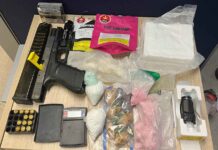
THUNDER BAY – Despite the best efforts of police in targetting drug dealers, despite the best efforts in education, and despite the hopes of parents, Thunder Bay continues to see increased rates in deaths related to opioids.
Today, local emergency first-responders joined representatives from the health and harm reduction sector for a joint news conference Wednesday, June 26 to discuss how the growing opioid overdose crisis is expected to impact emergency services and the community in the coming months.
This month Public Health Ontario released preliminary numbers for the final quarter of 2018, showing Thunder Bay District appears to have recorded 44 opioid-related deaths for that year. Those numbers represent a 40 percent increase in fatal opioid overdose cases over 2017. These statistics match what emergency first-responders are seeing on the frontlines as the number of calls for service involving opioid overdose cases continues to steadily rise.
Thunder Bay has recorded more overdose deaths than any of city in Ontario according to that report.
From January to May of this year, paramedics with the Thunder Bay Superior North EMS responded to 176 opioid-related calls. Meanwhile, paramedics, Thunder Bay Fire Rescue firefighters and Thunder Bay Police Service officers have collectively administered Naloxone to people suffering from suspected opioid overdoses on 53 occasions in that same time period.
First responders are also aware of at least 81 instances in which bystanders administered Naloxone to a person suffering from a suspected opioid overdose. The number of incidents in which Naloxone is used by a bystander appears to be rising and is possibly under-reported.
“I think it is really important for the public to understand that when you administer Naloxone (as a bystander) we ask that you call 9-1-1 and ensure that we continue to respond,” says Superior North EMS Dep.-Chief Andrew Dillon. “We are getting a number of callbacks where a person has regained consciousness and EMS isn’t needed anymore. The reality is, potentially an hour or an hour-and-a-half later, they may relapse into an episode or period of unconsciousness.”
“The people who work in Thunder Bay Fire Rescue have clearly indicated to me that there is an increase in occurrences of situations in which there is violence,” says Thunder Bay Fire Rescue Dep.-Chief Greg Hankkio.
“The statistics that have been shared with you today should leave no doubt in anyone’s mind that this is a crisis in the community and it is having a dramatic impact on first responders and the people who are trying to help deal with the situation.”
The Thunder Bay District Health Unit and local pharmacies distributed 3,872 Naloxone kits between July 2017 and June 2018. The number of kits distributed in Thunder Bay – 2,499 per 100,000 residents – was the highest distribution rate in Ontario.
“While we have made great inroads with the distribution of naloxone, there is still more to be done to address this crisis,” says Cynthia Olsen, Drug Strategy Coordinator. “With a toxic drug supply, individuals who use substances – even recreationally – are at risk. If at all possible, do not use alone, and have a naloxone kit handy, or use the Consumption and Treatment Service at NorWest Community Health Centres.”
“From a public health perspective, we need to focus on the underlying issues to be able to address this crisis,” says Tanelle Rabachuk, Director of Health Protection at the Thunder Bay District Health Unit.
“As a community, we need to consider the social determinants of health in every discussion we have. Access to proper housing, food, employment and schooling will play an important role in combating the rising overdose rates. Increased access to services such as primary care and mental health and addiction in a coordinated approach will be needed to support people where they are in their journey”.
As our emergency responders and community support agencies have indicated, opioid overdoses are trending upward. We are most likely facing a very busy and dangerous summer for the members of our community who struggle with addiction or use substances recreationally. Today is a call for more support for the programs and people who are making a difference in this health and public safety crisis.
“I am proud of the accomplishments and ongoing efforts of our joint force operation and the work of our members in the Intelligence Unit, however, we cannot arrest our way out of this problem,” says Thunder Bay Police Service S/Sgt. Shawn Harrison. “As a police service we will continue our efforts to disrupt the drug trade, but the growing problem of substance abuse and addiction will continue to provide the black market with more opportunities and incentive to come to Thunder Bay and take advantage of some of our most vulnerable.”
EMS, Fire and Police will continue to be on the frontline saving lives, but there must be more emphasis on making our communities safe and healthy. Harm reduction, treatment and support for those who suffer and deal with addictions must continue. It will take a combined effort.
The Drug Strategy will continue to monitor and respond to substance use-related harms through efforts in prevention, treatment, harm reduction, enforcement and housing.






